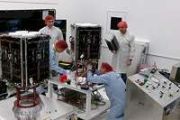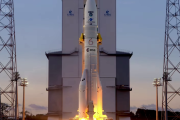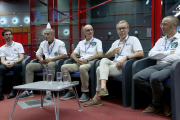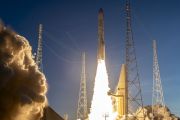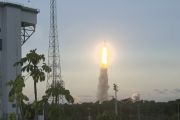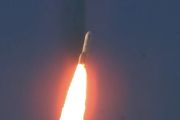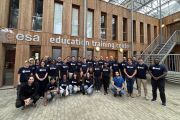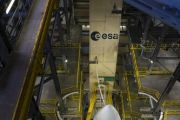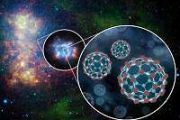
Copernical Team
Simulating Aeolus's return: mission control feels the heat
 No two missions are the same but launches have many milestones and features in common with each other: a satellite or spacecraft is launched on a gravity-defying rocket into space, after it separates and, exact sequences differ but it is woken up, solar arrays are deployed, instruments are switched on and tested and its thrusters are fired to get it where it needs to be.
Five years ago, Ae
No two missions are the same but launches have many milestones and features in common with each other: a satellite or spacecraft is launched on a gravity-defying rocket into space, after it separates and, exact sequences differ but it is woken up, solar arrays are deployed, instruments are switched on and tested and its thrusters are fired to get it where it needs to be.
Five years ago, Ae How an "AI-tocracy" emerges
 Many scholars, analysts, and other observers have suggested that resistance to innovation is an Achilles' heel of authoritarian regimes. Such governments can fail to keep up with technological changes that help their opponents; they may also, by stifling rights, inhibit innovative economic activity and weaken the long-term condition of the country.
But a new study co-led by an MIT professo
Many scholars, analysts, and other observers have suggested that resistance to innovation is an Achilles' heel of authoritarian regimes. Such governments can fail to keep up with technological changes that help their opponents; they may also, by stifling rights, inhibit innovative economic activity and weaken the long-term condition of the country.
But a new study co-led by an MIT professo PSI's David Grinspoon Appointed to New NASA Post
 David Grinspoon, a Senior Scientist at Planetary Science Institute has been appointed by NASA to be the new Senior Scientist for Astrobiology Strategy. Astrobiology is the study of the origin, evolution and distribution of life in the universe. As Senior Scientist for Astrobiology Strategy at NASA Grinspoon will serve as the Agency's senior leader for astrobiology, spearheading efforts from NASA
David Grinspoon, a Senior Scientist at Planetary Science Institute has been appointed by NASA to be the new Senior Scientist for Astrobiology Strategy. Astrobiology is the study of the origin, evolution and distribution of life in the universe. As Senior Scientist for Astrobiology Strategy at NASA Grinspoon will serve as the Agency's senior leader for astrobiology, spearheading efforts from NASA NASA's IXPE fires up astronomers with new blazar findings
 The universe is full of powerful supermassive black holes that create powerful jets of high-energy particles, creating sources of extreme brightness in the vastness of space. When one of those jets points directly at Earth, scientists call the black hole system a blazar.
To understand why particles in the jet move with great speeds and energies, scientists look to NASA's IXPE (Imaging X-ra
The universe is full of powerful supermassive black holes that create powerful jets of high-energy particles, creating sources of extreme brightness in the vastness of space. When one of those jets points directly at Earth, scientists call the black hole system a blazar.
To understand why particles in the jet move with great speeds and energies, scientists look to NASA's IXPE (Imaging X-ra The Lion's Mane: Sols 3892-3893
 Earth planning date: Monday, July 17, 2023. Today we planned a two sol "Touch and Go" plan. Our weekend drive successfully brought us about 28 metres, bringing us closer to the "crater cluster," a series of small craters grouped close together. These craters were created by meteoroid impacts, probably from a single meteoroid that broke up before it reached the surface.
So this mini campaig
Earth planning date: Monday, July 17, 2023. Today we planned a two sol "Touch and Go" plan. Our weekend drive successfully brought us about 28 metres, bringing us closer to the "crater cluster," a series of small craters grouped close together. These craters were created by meteoroid impacts, probably from a single meteoroid that broke up before it reached the surface.
So this mini campaig Psyche enters home stretch before launch
 Engineers and technicians at Cape Canaveral are preparing the Psyche spacecraft for liftoff, which is slated for Oct. 5.
With less than 100 days to go before its Oct. 5 launch, NASA's Psyche spacecraft is undergoing final preparations at Cape Canaveral, Florida. Teams of engineers and technicians are working almost around the clock to ensure the orbiter is ready to journey 2.5 billion mile
Engineers and technicians at Cape Canaveral are preparing the Psyche spacecraft for liftoff, which is slated for Oct. 5.
With less than 100 days to go before its Oct. 5 launch, NASA's Psyche spacecraft is undergoing final preparations at Cape Canaveral, Florida. Teams of engineers and technicians are working almost around the clock to ensure the orbiter is ready to journey 2.5 billion mile Timeline unveiled for China's advanced manned spacecraft's inaugural flight
 China's advanced manned spacecraft is set to embark on its maiden voyage sometime around 2027 and 2028, as revealed by a prominent figure in the nation's manned space program. This innovative development in space technology is currently undergoing research and development, anticipating a capacity to accommodate up to seven astronauts on a single journey, as reported in the Science and Technology
China's advanced manned spacecraft is set to embark on its maiden voyage sometime around 2027 and 2028, as revealed by a prominent figure in the nation's manned space program. This innovative development in space technology is currently undergoing research and development, anticipating a capacity to accommodate up to seven astronauts on a single journey, as reported in the Science and Technology Commercial space projects expected to provide more services in China
 China unveiled a series of commercial space projects at the recent 9th China (International) Commercial Aerospace Forum held in Wuhan. The programs are expected to provide more service in sectors such as natural resources survey, disaster warning and remote sensing.
The projects include an ultra-low orbit satellite constellation, the Tianmu meteorological constellation, Luojia-2 SAR remote
China unveiled a series of commercial space projects at the recent 9th China (International) Commercial Aerospace Forum held in Wuhan. The programs are expected to provide more service in sectors such as natural resources survey, disaster warning and remote sensing.
The projects include an ultra-low orbit satellite constellation, the Tianmu meteorological constellation, Luojia-2 SAR remote Raytheon, Northrop Grumman secure further hypersonic weapon development contract
 Raytheon, an RTX business entity, and Northrop Grumman Corporation have obtained a subsequent contract from the Defense Advanced Research Projects Agency (DARPA) to progress in the field of air-breathing hypersonic systems. This contract signals a commitment to the Hypersonic Air-breathing Weapon Concept (HAWC) as the companies seek to construct and test additional flight vehicles.
The amb
Raytheon, an RTX business entity, and Northrop Grumman Corporation have obtained a subsequent contract from the Defense Advanced Research Projects Agency (DARPA) to progress in the field of air-breathing hypersonic systems. This contract signals a commitment to the Hypersonic Air-breathing Weapon Concept (HAWC) as the companies seek to construct and test additional flight vehicles.
The amb Studying solar flares and sunspots can help protect Earth
 In 1859, the Carrington Event, the most intense geomagnetic storm in recorded history, created spectacular auroral displays around the globe, illuminating the night skies so brightly that birds began singing and laborers set off for work, mistakenly believing the sun had risen.
Telegraph systems around the world - essential for communication at the time - began to fail as fires sparked and
In 1859, the Carrington Event, the most intense geomagnetic storm in recorded history, created spectacular auroral displays around the globe, illuminating the night skies so brightly that birds began singing and laborers set off for work, mistakenly believing the sun had risen.
Telegraph systems around the world - essential for communication at the time - began to fail as fires sparked and 





